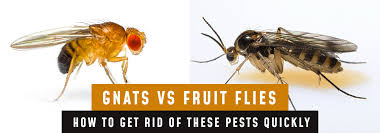Fruit flies and gnats are common household pests that often cause confusion due to their similar appearance and behavior. However, they belong to different families and have distinct characteristics, habitats, and control methods. Fruit flies have a rounded silhouette like a smaller version of the common house fly. On the other hand, fungus gnats feature dangling legs and long bodies that make them appear similar to a small mosquitoes. , Fruit flies vs Gnats.
Appearance
- Fruit Flies: Typically measuring about 1/8 inch long, fruit flies have a tan-to-black coloration and are easily recognized by their large, red eyes. They have a rounded body shape similar to that of a small housefly, with transparent wings that extend beyond their abdomen when at rest.
- Gnats: Fungus gnats are slightly smaller and usually dark gray or black. They have long, slender bodies with dangling legs, resembling miniature mosquitoes. Their eyes are small and often difficult to see, and they tend to have a more elongated shape compared to fruit flies. , Fruit flies vs Gnats.
Distinguishing Features

While both fruit flies and gnats are small and can be challenging to differentiate at a glance, there are some key distinguishing features:
- Appearance: Fruit flies are typically more robust with a rounded body, whereas gnats have a more slender, mosquito-like appearance. Fruit flies usually have red eyes, while gnats do not.
- Habitat: Fruit flies are primarily found around food sources, particularly fermenting fruits and vegetables. Gnats are often associated with plants or areas with excess moisture, such as soil or drains.
- Control Methods
- Fruit Flies: To manage fruit fly infestations, it is essential to eliminate their food sources. This includes regularly cleaning kitchen surfaces, disposing of overripe fruits, and keeping trash cans sealed. Traps can also be effective, such as vinegar traps or commercially available fruit fly traps.
- Gnats: Controlling gnats involves addressing moisture levels and inspecting houseplants. Avoid overwatering plants, and consider replacing potting soil to remove larvae. Using a layer of gravel on top of the soil can help reduce moisture and deter gnats. Natural remedies, such as cinnamon, can also be used to prevent infestations as it acts as a fungicide.
- Conclusion
- ruit flies and gnats may seem similar at first glance, they have different characteristics, habitats, and control methods. Identifying which pest is causing the problem in your home is the first step toward effective management. , while fruit flies and gnats may appear similar and share some habitat preferences, they have distinct differences in appearance, behavior, and control methods. Understanding these differences can help homeowners effectively manage and eliminate these pests.
